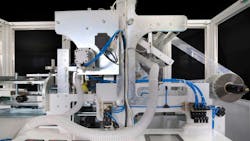How are Hydraulics and Pneumatics Evolving for Industrial Applications?
Hydraulics and pneumatics are utilized in a wide range of industrial applications from machine tools and packaging machinery to production of semiconductors, food products and more. As these applications continue to evolve to meet demand for increased productivity and efficiency, so too do the fluid power technologies utilized within them.
Starting October 13, we’ll be highlighting some of the ways industrial fluid power technologies are evolving through our “takeover week” during which we’ll publish several new pieces of content focused on topics related to the use of hydraulics and pneumatics in industrial, also referred to as in-plant, applications.
Topics covered during our focus on industrial fluid power include a dive into the benefits pneumatic systems offer applications such as semiconductor production as well as a look at how variable speed hydraulic pump technology is bringing efficiency gains to a range of applications.
We will also be publishing a new report examining the trends shaping the design of hydraulic and pneumatic systems to ensure they continue meeting the requirements of industrial applications. Insights included in the report are based on a recent reader survey as well as discussions with members of the fluid power industry to ensure a wide range of perspectives were collected.
What is a takeover week?
Power & Motion takeover weeks are designed to provide a hyper-focused look at topics, trends and industries of importance to the fluid power industry as well as the broader power transmission and motion control spaces in which fluid power works.
Through a series of new articles, video interviews and other content we aim to help the industry gain a better understanding of technologies and trends influencing it. If you missed any of our previous takeovers, you can download the e-books below to read the content created for them. And if you have suggestions for future takeovers, let us know!
Sensors: New Technologies and Trends
Technology Advancements for Pneumatic Systems
The Continued Evolution of Mobile Hydraulics
Sustainability Technologies and Trends
Technology Advancements for Mobile and Industrial Machinery Automation
We’ll be rounding out our industrial fluid power coverage with a piece offering tips on selecting the right pneumatic actuator technology and two application stories which offer a look at the benefits that can be achieved when failing systems are replaced with newer and more customized options.
Through these articles, and our takeover week in general, we aim to showcase not only the technological developments and use cases for fluid power but also the continued importance of hydraulics and pneumatics in a range of applications.
So be sure to visit our website the week of October 13 to learn about the world of industrial fluid power. If you want to ensure you don’t miss any of this takeover week content, make sure you’re subscribed to our Power & Motion News e-newsletter — we’ll be sending an email each day highlighting the newest industrial fluid power content as well as other coverage we’ve done related to the topic.
Have thoughts on future industrial fluid power topics we should cover, or application stories to share? Let me know by reaching out to me at [email protected].
With fluid power remaining an important technology to industrial applications, we want to know, what are those applications in which you see opportunities for hydraulics and pneumatics in the future. Take our poll below to let us know!
About the Author
Sara Jensen
Executive Editor, Power & Motion
Sara Jensen is executive editor of Power & Motion, directing expanded coverage into the modern fluid power space, as well as mechatronic and smart technologies. She has over 15 years of publishing experience. Prior to Power & Motion she spent 11 years with a trade publication for engineers of heavy-duty equipment, the last 3 of which were as the editor and brand lead. Over the course of her time in the B2B industry, Sara has gained an extensive knowledge of various heavy-duty equipment industries — including construction, agriculture, mining and on-road trucks —along with the systems and market trends which impact them such as fluid power and electronic motion control technologies.
You can follow Sara and Power & Motion via the following social media handles:
X (formerly Twitter): @TechnlgyEditor and @PowerMotionTech
LinkedIn: @SaraJensen and @Power&Motion
Facebook: @PowerMotionTech

Leaders relevant to this article:

